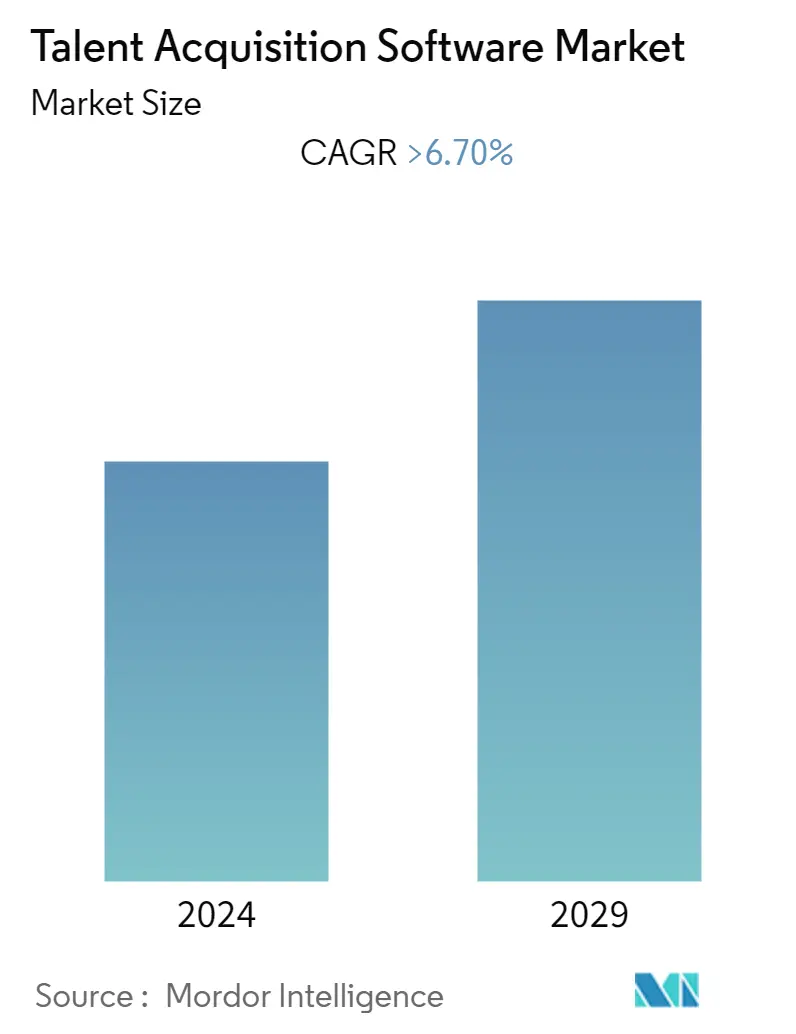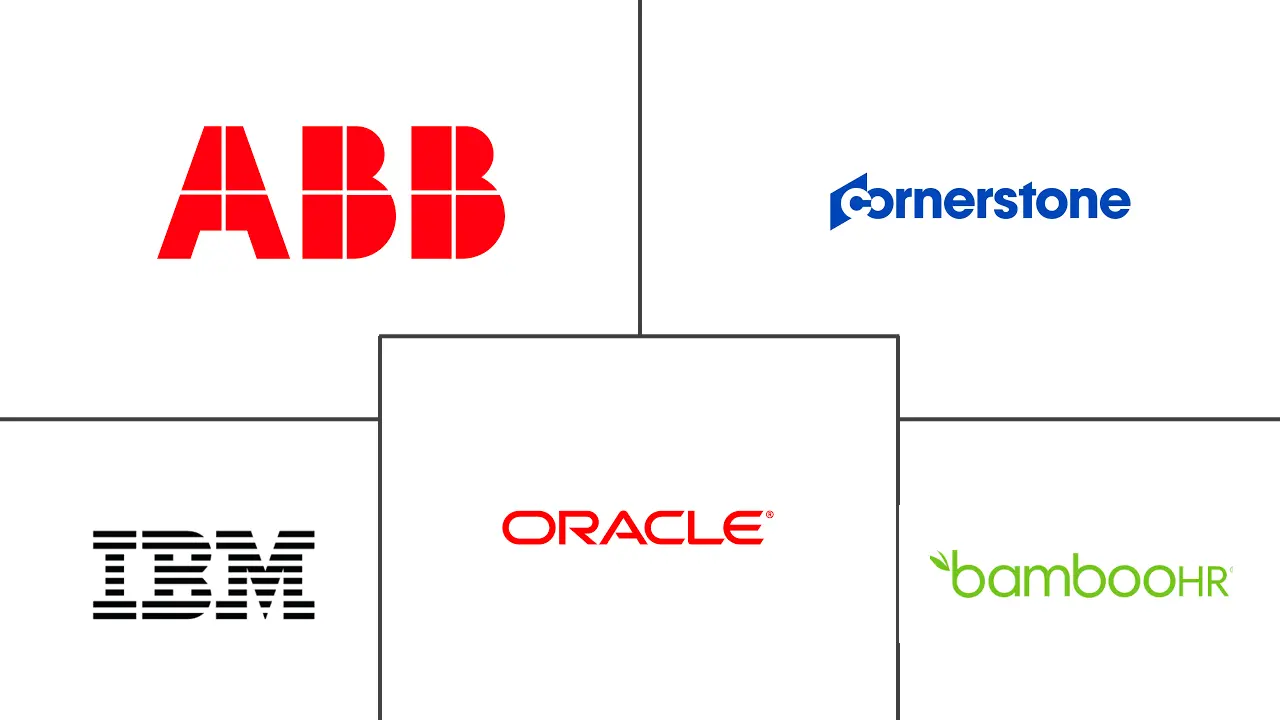Market Size of Talent Acquisition Software Industry

| Study Period | 2019 - 2029 |
| Base Year For Estimation | 2023 |
| CAGR | > 6.70 % |
| Fastest Growing Market | Asia-Pacific |
| Largest Market | North America |
| Market Concentration | Medium |
Major Players
*Disclaimer: Major Players sorted in no particular order |
Need a report that reflects how COVID-19 has impacted this market and its growth?
Talent Acquisition Software Market Analysis
The talent acquisition software market is anticipated to register a CAGR of 6.7% during the forecasted period. The rise in the use of cloud-based solutions and the growing need for real-time employee engagement models are the prime factors driving the growth of the talent acquisition software market. Talent acquisition software primarily increases hiring quality, speeds recruitment, and minimizes administration work. Key factors encouraging the development of the talent acquisition software market are the rising demand for talent mobility, adopting paperless or cloud-based business models in HRM services, and advancing AI and machine learning technologies. The market is expected to be further fueled by other factors, such as the emergence of social recruiting trends, a growing need to replace traditional hiring processes to reduce paperwork, wastage of resources and costs, and the rising number of start-up businesses, particularly in developing economies.
- Key market drivers are the rising demand for improved recruiter efficiency and communication, the growing acceptance of cloud-based solutions, and the increased requirement to expedite hiring procedures. These factors sparked advancements in the talent acquisition software market. Using artificial intelligence in hiring might help businesses cut back on or even do away with time-consuming tasks like manually scanning resumes. Vendors in this industry implement talent acquisition software that enables smooth management of the complete recruitment cycle, from position creation to candidate selection.
- Software companies worldwide come up with new solutions to sustain themselves in the market. For instance, Hirebee announced starting the Hirebee Bespoke 2021 Program. Hireable Bespoke 2021 is a thriving community of talent leaders, recruiters, and field experts that can share their recruiting needs, find the best solutions to their problems with Hirebee and join their commission-based referral program to help the movement grow.
- Players in the market provide SaaS recruitment software. It is more adaptable, as the program can be accessed on mobile devices anytime and from any location. Thus, the availability of recruitment software on mobile phones raises market demand for software.
- The increasing use of mobile-based recruitment systems and the increasing penetration of cloud-based platforms drive the growth of the recruitment software industry. Furthermore, the introduction of automated resume screening technologies that employ artificial intelligence (AI) to assess a candidate's abilities and expertise boosts the market growth.
- Recruiter chatbots are also gaining traction in the online recruitment sector. A recruiter's chatbot communicates with applicants in real-time by asking targeted queries. Chatbots driven by artificial intelligence are expected to elevate the candidate experience. Job searchers are more likely to have a positive opinion of a business if they receive regular updates during the application process. Thus, increased awareness of the benefits of AI-integrated recruiting strategies is likely to drive market expansion throughout the forecast period.
- One of the key restraints for the talent acquisition software market is a lack of awareness in various industries. Many commercial businesses employ old-fashioned, conventional techniques and have not switched to modern alternatives to streamline the procedure. Moreover, some companies are not ready to invest in software solutions, which in turn, hampers the market growth.
- The COVID-19 pandemic brought significant growth opportunities for the talent management software market. People relied heavily on software to run businesses efficiently throughout the lockdown. Companies seeking staff during this pandemic used talent management software to hire and manage their operations. Many companies hired workers to work as independent contractors and used talent management software.
- The COVID-19 pandemic had two effects on HR technology. Employment rates fell, with many individuals losing their jobs as businesses were forced to furlough or downsize. This created a substantial workload for human resources, much of which had to be completed remotely due to COVID-19 constraints and precautions.
Talent Acquisition Software Industry Segmentation
Recruiters, talent acquisition specialists, and hiring managers utilize talent acquisition software to expedite or automate their workflow, including sourcing, screening, interviewing, and onboarding. These software are an overall combination of interviewing software, candidate relationship management (CRM) systems, and application tracking systems (ATS). It can also do background checks and pre-hire assessments, followed by onboarding training and orientation for new hires, thereby improving the effectiveness of recruiting managers and businesses. Organizations typically use them to manage candidate databases, post job openings, handle applications, arrange interviews, and get candidate feedback.
The talent acquisition software market is segmented by type (on-premises solutions, on-demand solutions), by enterprise size (large enterprises, SMEs), by industry (manufacturing, healthcare, BFSI, education, hospitality, other industries), and by geography
| By Type | |
| On-premises Solutions | |
| On- demand Solutions |
| By Enterprise Size | |
| Large Enterprises | |
| SMEs |
| By Industry | |
| Manufacturing | |
| Healthcare | |
| BFSI | |
| Education | |
| Hospitality | |
| Other Industries |
Talent Acquisition Software Market Size Summary
The talent acquisition software market is expected to witness significant growth, driven by the increasing adoption of cloud-based solutions and the need for real-time employee engagement models. The software enhances the quality of hiring, accelerates recruitment, and reduces administrative work. Other factors contributing to the market growth include the rising demand for talent mobility, adoption of paperless or cloud-based business models in HRM services, and advancements in AI and machine learning technologies. The emergence of social recruiting trends, the need to replace traditional hiring processes, and the increasing number of start-up businesses, particularly in developing economies, are also expected to fuel the market growth. Key market drivers include the rising demand for improved recruiter efficiency and communication, growing acceptance of cloud-based solutions, and the need to expedite hiring procedures. The use of artificial intelligence in hiring can help businesses reduce or eliminate time-consuming tasks such as manually scanning resumes. Vendors in this industry offer talent acquisition software that facilitates smooth management of the entire recruitment cycle, from position creation to candidate selection. The increasing use of mobile-based recruitment systems and the growing penetration of cloud-based platforms are also driving the growth of the recruitment software industry. However, a lack of awareness in various industries and reluctance to invest in software solutions are some of the challenges faced by the market.
Explore MoreTalent Acquisition Software Market Size - Table of Contents
-
1. MARKET DYNAMICS
-
1.1 Market Overview
-
1.2 Market Drivers
-
1.2.1 Rising Use of Cloud-based Solutions
-
1.2.2 Surge in the Need for Real-time Employee Engagement Models
-
-
1.3 Market Restraints
-
1.3.1 Lack of Awareness
-
-
1.4 Value Chain/Supply Chain Analysis
-
1.5 Porter's Five Force Analysis
-
1.5.1 Threat of New Entrants
-
1.5.2 Bargaining Power of Buyers/Consumers
-
1.5.3 Bargaining Power of Suppliers
-
1.5.4 Threat of Substitute Products
-
1.5.5 Intensity of Competitive Rivalry
-
-
1.6 PESTLE Analysis
-
-
2. MARKET SEGMENTATION
-
2.1 By Type
-
2.1.1 On-premises Solutions
-
2.1.2 On- demand Solutions
-
-
2.2 By Enterprise Size
-
2.2.1 Large Enterprises
-
2.2.2 SMEs
-
-
2.3 By Industry
-
2.3.1 Manufacturing
-
2.3.2 Healthcare
-
2.3.3 BFSI
-
2.3.4 Education
-
2.3.5 Hospitality
-
2.3.6 Other Industries
-
-
Talent Acquisition Software Market Size FAQs
What is the current Talent Acquisition Software Market size?
The Talent Acquisition Software Market is projected to register a CAGR of greater than 6.70% during the forecast period (2024-2029)
Who are the key players in Talent Acquisition Software Market?
ABB, Cornerstone OnDemand, IBM, Oracle and Bamboohr are the major companies operating in the Talent Acquisition Software Market.
